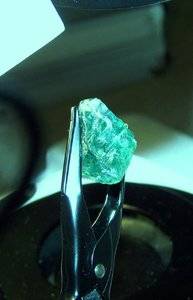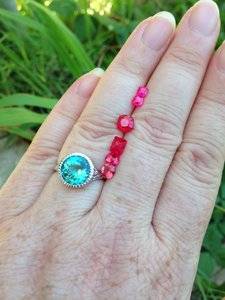ExoticGems
Rough_Rock
- Joined
- Oct 31, 2017
- Messages
- 27
Paraíba tourmaline comes from Brazil, just as Valeria101 said above. It is a copper bearing tourmaline of the variety elbaite (cuprian elbaite). Another copper bearing tourmaline was discovered in Mozambique. I believe it is now acceptable to call all cuprian elbaite Paraiba, but anyone selling it should be able to tell you the stone’s origin. Mozambique’s material is less expensive. I know Nigeria produces beautiful tourmaline, but I haven’t heard of any cuprian elbaite coming from Nigeria. Maybe someone from the trade can weigh in. Also hopefully, someone can tell you where to test for copper.
As others have said, AGL can do this for you. I don't think it is cheap though. I might be mistaken, but I think they make you pay more than just "Gem Brief" prices for the analysis, due to the complexity of determining copper content. You might want to give them a call to see what they would charge.


The ring in this photo is a blue untreated supposed to be Nigerian (certified from AGL) copper bearing "paraiba" tourmaline that is supposed to have originated from the first deposit ever found in Nigeria. I say supposed to because that is what I was told when it was purchased and testing has not contradicted that. Since then most of it from Nigeria hasn't been the same quality material according to what I have read.
You will probably need to have at least one face of it faceted so they can test it, I just sent some rough Kornerupine to a lab and they prefer a faceted face to work with apparently.

Copper or no copper, that is one outstanding tourmaline!The ring in this photo is a blue untreated supposed to be Nigerian (certified from AGL) copper bearing "paraiba" tourmaline that is supposed to have originated from the first deposit ever found in Nigeria. I say supposed to because that is what I was told when it was purchased and testing has not contradicted that. Since then most of it from Nigeria hasn't been the same quality material according to what I have read.
You will probably need to have at least one face of it faceted so they can test it, I just sent some rough Kornerupine to a lab and they prefer a faceted face to work with apparently.

The AGL cert confirmed it's an untreated "paraiba" copper bearing tourmaline but even they from what I understand are not 100% sure of origin.
The ring in this photo is a blue untreated supposed to be Nigerian (certified from AGL) copper bearing "paraiba" tourmaline that is supposed to have originated from the first deposit ever found in Nigeria. I say supposed to because that is what I was told when it was purchased and testing has not contradicted that. Since then most of it from Nigeria hasn't been the same quality material according to what I have read.
You will probably need to have at least one face of it faceted so they can test it, I just sent some rough Kornerupine to a lab and they prefer a faceted face to work with apparently.

Origin opinions are always that, opinions. Hence you see several major labs issue different origins for stones sometimes.